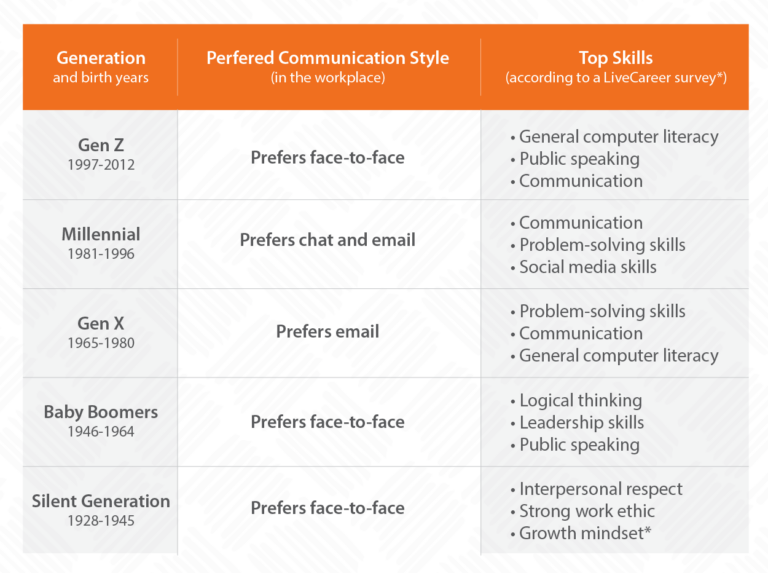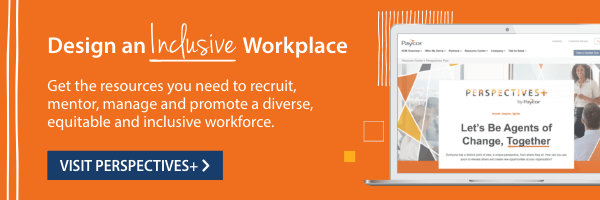Today’s workforce spans five generations, from Generation Z all the way up to the Silent Generation. Millennials and Generation X make up the majority of the workforce, but Baby Boomers and Gen Z hold a significant share too. According to the U.S. Bureau of Labor Statistics, people ages 75+ accounted for just 1.1 percent of the labor workforce in 2022.
With five generations working, and Gen Alpha set to join the workforce over the next decade, it’s important to know how to effectively manage each generation, bridge generational divides and harness diverse talents and perspectives.
Read on to learn how to effectively manage different generations in the workplace.
Current Generations in the Workforce
The following graphic outlines the current generations in the workplace:

*Did not respond to LiveCareer survey.
Benefits of Generational Diversity in the Workplace
In LiveCareer’s 2022 Different Generations in the Workplace Study, 89% of the 1,000+ respondents reported they somewhat or strongly agree that workplace generational diversity is a positive thing. 87% somewhat or strongly agree that different generations can learn from each other when working together.
Benefits gained from a multigenerational workforce include:
- Mentorship opportunities: Like the 87% or respondents reported, different generations have much to learn from each other. A multigenerational workforce creates natural mentorship opportunities.
- Enhanced innovation: A diverse workforce brings together different perspectives, which can lead to more innovative solutions and creative problem-solving.
- Broader skillset: As seen in the table above, each generation brings their strengths to the company, leading to a well-rounded workforce. For example, Gen Z are digital natives with advanced technology skills, while baby boomers offer quality leadership.
- Improved decision-making: A healthy mix of life experiences and fresh ideas leads to more balanced and thoughtful decisions.
- Better customer relations: A multigenerational workforce can better connect with a diverse customer base, reflecting the varying age groups and preferences of customers.
How to Manage Different Generations
From communication styles and workplace values to preferred leadership style, there’s much to consider when managing different generations. Level up your management and leadership skills with these five tips.
1. Communicate effectively
There are multiple communication styles across the generations. For example, a baby boomer typically wants to meet in person, while Gen X may prefer an email. Try to call a Millennial and they probably won’t answer the phone. And of course, there are outliers in each generation.
Try to communicate in different ways to effectively reach each team member. Utilize a mix of communication methods, such as face-to-face meetings, emails, phone calls and instant messaging, to ensure everyone stays informed and engaged.
2. Recognize people appropriately
Consider how your employees want to be recognized for their work, and how often. According to a Gallup and Workhuman study titled Empowering Workplace Culture Through Recognition, employees who receive great recognition are 20 times as likely to be engaged.
Still, recognition is not one-size-fits-all. Gallup data shows that younger generations (Gen Z, millennials) prefer frequent recognition, while older generations (Baby Boomers) are more likely to say they don’t want recognition.
Even the respondents who say they never want recognition become more engaged when recognized. Because recognition works, it’s important to discover how your employees want to be recognized. Gallup research shows only 10% of employees have been asked how they would like to be recognized. Simply asking them shows you care and are invested in their growth.
3. Build diverse teams
Diverse teams benefit from the varied perspectives and experiences each generation brings. When building teams, consider pairing employees from different generations on projects to promote knowledge sharing and mentorship. Encourage collaboration by setting up systems that allow all voices to be heard, fostering a company culture where everyone feels valued.
4. Maintain a flexible management style
The different generations want different qualities from their managers. According to data from Great Place to Work, Millennials want communicative and empathetic leaders who provide regular feedback and show up at critical moments in their career and personal life. On the other hand, Boomers expect their managers to be more hands-off and focused on building the company.
While you can’t be all things to all people at all times, you can maintain a flexible management style to meet employees where they are. This might mean adopting a situational leadership approach, where you adjust your management style based on the specific needs of the employee or the situation at hand. For example, you might take a more hands-on approach with a newer employee who is still learning the ropes, while giving more experienced employees the autonomy they desire.
5. Focus on inclusivity
Inclusivity is crucial in managing a diverse workforce. Ensure your policies, practices and workplace culture make all generations — and people of all races, genders, ethnicities, etc. — feel included. Implement regular team-building activities that bring together employees from different generations and backgrounds to foster understanding and collaboration.
When making decisions or implementing changes, seek input from employees across all generations to ensure diverse perspectives are considered. This leads to more inclusive and effective outcomes that benefit the entire workforce.
Remember that while generational differences exist, it’s important not to overgeneralize. Individuals within each generation have diverse personalities, preferences and work styles. Always strive to understand and accommodate individual needs while building a cohesive and inclusive work environment for all.
How to Overcome Generational Differences in the Workplace
Implement the following tips and strategies for bridging generational divides in your workplace:
- Foster a culture of mutual respect and understanding through diversity and inclusion training that specifically addresses generational differences.
- Offer a competitive benefits package that considers benefits for different life stages, such as student loan repayment assistance, flexible schedules and retirement planning.
- Implement mentorship programs, pairing older generations and younger generations together so they can learn from each other.
- Adapt management and communication styles to fit employee preferences.
- Provide continuous learning opportunities to help bridge skill gaps and build a more cohesive team.
- Create cross-generational project teams to encourage collaboration and knowledge sharing among employees of different age groups.
- Consider flexible working arrangements that allow all generations to work in the way that best works for them, whether in office or remotely.
- Establish an open feedback system that allows employees of all generations to voice their ideas, concerns and suggestions without fear of judgment.
How Paycor Helps
While a multigenerational workplace offers many benefits, it requires a strong leader to bridge generational divides and harness the unique strengths of all team members. Paycor’s Talent Management software is purpose-built to empower leaders who build workplaces where employees thrive, contribute and succeed—all in sync with each other. From Talent Development tools to Pulse surveys that gather employee feedback, Paycor offers the tools you need to succeed as a leader of a diverse workforce.










